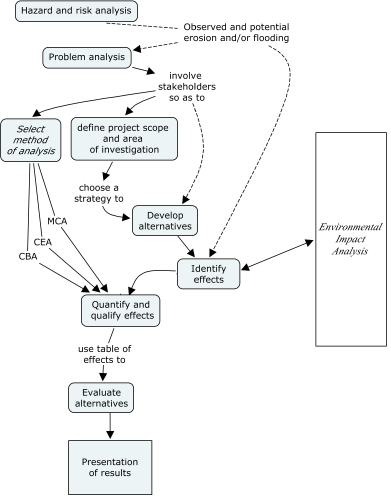Difference between revisions of "Socio-economic evaluation"
(→References) |
(→References) |
||
| Line 29: | Line 29: | ||
==References== | ==References== | ||
* Boardman,A., Greenberg,D., Vining,A., Weimer,D. (2001) Cost-Benefit Analysis – Concepts and Practice, Second edition. | * Boardman,A., Greenberg,D., Vining,A., Weimer,D. (2001) Cost-Benefit Analysis – Concepts and Practice, Second edition. | ||
| − | * Guide to cost-benefit analysis of investment projects. ( | + | * Guide to cost-benefit analysis of investment projects. (2002). European Commission, DG Regional Policy. [http://ec.europa.eu/regional_policy/sources/docgener/guides/guide_en.htm Download page] |
| − | * Guidelines for incorporating cost benefit analysis into the implementation of shoreline management measures. Eurosion project, 2004. [http://www.eurosion.org/reports | + | * Guidelines for incorporating cost benefit analysis into the implementation of shoreline management measures. Eurosion project, 2004. [http://www.eurosion.org/reports-online/reports.html Download page] |
* Messina, (2005). Socio-economic methods for evaluating decisions in coastal erosion management – State-of-the-art Messina, Component 3, September 2005. [http://www.interreg-messina.org/publications.htm Download page] | * Messina, (2005). Socio-economic methods for evaluating decisions in coastal erosion management – State-of-the-art Messina, Component 3, September 2005. [http://www.interreg-messina.org/publications.htm Download page] | ||
| − | * Messina, (2006). Guideline for socio-economic valuation of | + | * Messina, (2006). Guideline for socio-economic valuation of the shoreline. [http://www.interreg-messina.org/bestpractices.htm Download page] |
==See also== | ==See also== | ||
Revision as of 10:30, 2 July 2008
Contents
Introduction
The overall objective of socio-economic evaluation is to maximize the benefits of future investments in coastline management in a sound and sustainable way. Various forms of Socio-Economic evaluation are used to assist in Coastal Management and making decisions regarding the coastal zone. Any evaluation must have a starting point and purpose. In the case of coastal erosion projects knowledge is needed on "Monitoring and modeling the shoreline", "Engineering the shoreline", "Integrating the shoreline into spatial planning policies" and "Valuating the shoreline". Evaluation can be done in different phases of a project - "ex-ante", "in medias res" or "ex-post" (before, while or after a project is carried out". Regardless which phase of a project the same methods are applied. The steps of an evaluation is shown in the following flowchart:
Main methods of analysis
There are three basic forms or analysis. They all have a common starting step and that is the "Table of effects" listing all effects relevant to the evaluation for all alternatives evaluated.
- Cost-Benefit Analysis (CBA)
- Cost-Effectiveness Analysis (CEA)
- Multi-Criteria Analysis (MCA)
The Cost-Benefit Analysis (CBA) is an evaluation method that gives an overview of the advantages and disadvantages of project alternatives or measures in terms of social welfare. These advantages and disadvantages are presented in the form of cost items and benefit items on a cost-benefit balance sheet. The items are expressed in terms of money (“monetised”) as far as possible to enable the various project alternatives to be compared. The main question in a Cost Benefit Analysis is “Do the benefits outweigh the costs?”. The welfare effect is expressed in the balance of all costs and benefits. The costs and benefits of alternatives can also be compared to determine which alternative is preferable.
The aim of a Cost-Effectiveness Analysis (CEA) is to determine with which measures or packages of measures (project alternative) an objective can be reached at the lowest cost possible (cost minimisation). The analysis method can also be used to determine which project alternative, given the maximum budget, that will contribute most to the achievement of the objective (effect maximisation). With a CEA, either the objective or the available amount of money is fixed.
A Multi-Criteria Analysis (MCA) give a decision-maker the opportunity to weigh a wide range of different effects against each other in the decision-making process. MCA methods can be used to get large quantities of dissimilar information into a manageable form for decision-making. A MCA produces a “weighted sum” of the project’s effects. For each project alternative, a number of criteria are used to give a weighing to each of the effects considered. The weightings determine how significant an effect is in the project alternative’s overall score. The various alternatives are ranked in order of preference based on overall scores.
Methods for valuation of effects
- Travel Cost Method (TCM)
- Hedonic Pricing Method (HPM)
- Contingent Valuation Method (CVM)
- Production Factor Method (PFM)
- Prevention Cost Method (PCM)
- Shadow Project Method (SPM)
- Benefit Transfer Method (BTM)
References
- Boardman,A., Greenberg,D., Vining,A., Weimer,D. (2001) Cost-Benefit Analysis – Concepts and Practice, Second edition.
- Guide to cost-benefit analysis of investment projects. (2002). European Commission, DG Regional Policy. Download page
- Guidelines for incorporating cost benefit analysis into the implementation of shoreline management measures. Eurosion project, 2004. Download page
- Messina, (2005). Socio-economic methods for evaluating decisions in coastal erosion management – State-of-the-art Messina, Component 3, September 2005. Download page
- Messina, (2006). Guideline for socio-economic valuation of the shoreline. Download page
See also
Internal Links
External Links
- Guideline and Case-studies available on Messina project website
Please note that others may also have edited the contents of this article.
|
